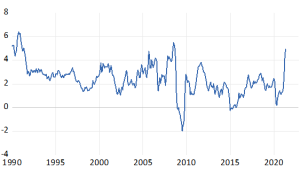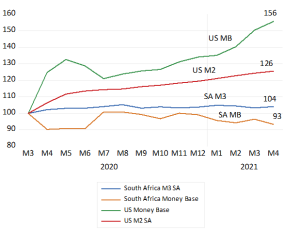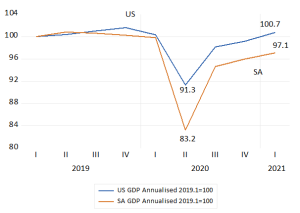The steps taken in the US to counter the destruction of incomes and output caused by the lockdowns of economic activity must be regarded as a resounding success. Real US output is now ahead of pre-covid levels. By the end of 2021 GDP may well have surpassed the GDP that might have been expected absent the lock downs. It took lots of income relief, checks in the post from Uncle Sam, supplemented by generous unemployment benefits and relief for businesses. The extra income means extra deposits, that is money with the US banks, to be spent later or exchanged for other financial assets or real estate or bitcoins or precious metals.
It has also taken lots of extra money, money in the form of deposits held by Banks with the Federal Reserve System have increased by 85%, and deposits at the commercial banks have grown by 26% since March 2020. The source of the extra cash and the deposits at the commercial banks and the Fed, has been additional purchases of government bonds and mortgage-backed securities in the debt markets from the banks and their clients – insurance companies and the like, that are being maintained at the rate of 120 billion dollars a month. The Assets and the Liabilities of the Fed have increased by 36%. It has been money creation on an awe-inspiring scale and it has worked as intended to promote demand for goods and services as excess holdings of money are exchanged for goods and services, that businesses are stimulated to supply and to employ more workers to help do so. The fact that they are struggling to keep up with demand, also struggling to add to payrolls, has meant significant upward pressure on prices. The US CPI was up by 5% in May – a rate of inflation not seen since 2008 and before then only in the nineteen nineties.
Inflation in the US – Annual percentage changes in the CPI (Monthly Data)
Source; Federal Reserve Bank of St.Louis and Investec Wealth and Investment
The outlook for inflation in the US is much less obvious than usual. The Fed has been surprised by the pick-up in the inflation rate as was indicated by its Open Market Committee and Governor Powell’s press conference held yesterday 16th June. But Powell remains confident that the increase in inflation is transitory and the Fed does not intend raising interest rates anytime soon, and not until the economy has returned to full employment which is judged to be some way off. Though full employment may mean fewer workers employed given that two million potential workers have withdrawn from the labour market since the lockdowns. They may however wish to return to employment should the opportunities to do so present themselves and is one of the uncertainties the Fed is trying to cope with post Covid for which there are no precedents as the Fed points out. A number of Fed officials however have brought forward the time when they think the Fed will first raise its key interest rates to Q1 2023, a revision that surprised the market and moved long term interest rates higher. Though the bond market remains of the view that inflation in the US over the next ten years will remain no higher than the 2% p.a. average rate targeted by the Fed. The fed as the market will be highly alert to the prospect that more inflation than this will come to be expected.
The contrast of the actions of the Fed with that of the South African Reserve Bank is striking. The SARB balance sheet contracted between March 2020 and May 2021 by R115b or by 10.8%. The sum of notes issued plus deposits of the banks with the SARB (the money base) has declined by 6% since January 2020 and the supply of bank deposits M3 has grown by a paltry 4% and bank credit by 2% since. Truly shocking figures for an economy struggling to escape a deep recession of the government’s making. The Reserve Bank must be of the view that money and credit do not matter for the economy, that changes in interest rates are the only instrument they have with which to influence the economy and that they have declined far enough. These are serious errors of judgment that have punished the economy unnecessarily severely.
South Africa and the USA Monetary Comparisons; March 2020=100
Source; Reserve Bank of South Africa, Federal Reserve Bank of St Louis and Investec Wealth and Investment
The Reserve Bank likes to believe their lower interest rate settings have been accommodative, that is helpful to the economy. Higher interest rates would have been very unhelpful and lower rates were called for. The money and credit numbers indicate only deeply depressing influences on the economy that the SARB could and should have done much more to relieve, following the US example. There is more to monetary policy and its influence on the economy than movements in interest rates.
GDP in the USA and South Africa. March 2000=100. Quarterly Data
Source; Reserve Bank of South Africa, Federal Reserve Bank of St Louis and Investec Wealth and Investment
It would be easy to despair of the prospects for the SA economy given the current trends in the supply of money and credit that are highly discouraging. But for the possibility that the US cavalry with some Chinese assistance may well rescue us in the form of rising prices for metals and minerals that are very much part of the inflation under way in the US. Metal prices have always led the SA business cycle in both directions. They may well lead us out of the current morass- and the supply of money and credit will then pick up momentum to reinforce the recovery- as they have always done in a highly pro-cyclical way. The responses to the lockdowns have made it very clear how our monetary policy leads with not against the winds blowing from the real economy. A favourable wind from offshore may lift the money supply and bank credit without which faster growth is not possible.


